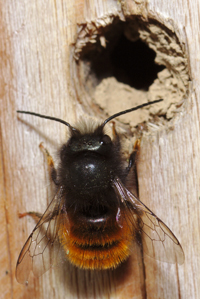by Steven Jakobi

A 60-tube commercial mason bee nest kit, partially occupied in June. Photo courtesy Steven Jakobi
Three years ago, I got a mason bee nest kit for a Christmas present. I confess that up to that point I had never heard of mason bees. The kit sat on a shelf for a year or so, but last year I decided to give it a try. I followed the instructions on the insert and I placed the nest in a sheltered area according to recommendations. Nothing happened. The contraption sat there without any insect activity all spring and summer and fall. I would periodically look at it, shrug my shoulders, and move on with my outdoor chores.
All of that changed this year. The mason bees discovered this wonderful nesting place and most of it has been occupied. Now I am excited because I have been reading about these amazing bees and their contribution as pollinators, and I welcome them to my garden.
A non-stinging species, the orchard mason bee is native to North America. It is one of several hundred kinds of bees world wide but, unlike the European honey bee, it is a solitary insect that does not have a queen, workers, soldiers, or other members of a hive. After a female breeds with one or several males, she begins to lay her eggs in tree bark crevices, cracks or channels in rocks, or tubular nesting places. Several eggs are deposited in one nesting site. Eggs that develop into females are laid first in the deepest part of the cavity and those destined to be males are at the outer edge. Then the outermost opening is plugged with mud, which forms a tight, secure cover over the eggs. It is for this reason that this animal is called a “mason bee.”

Mason bee at her future nursery. Photo courtesy Flickr: stanze
Like other bees and most wasps, mason bees have a complete life cycle that includes larval, pupal, and adult stages. Males emerge first from the nest and wait for the appearance of females. Once mating has taken place the males die, but the gravid female begins to collect large amounts of pollen for her eggs. As each of six to ten eggs is laid, a cache of pollen is deposited as a food source for the emerging larva. Each egg is in its own compartment, separated by a mud barrier from the next, so that there is no competition for food among the newly hatched babies.
It is during the collection of food for her eggs that that mason bee provides invaluable service to agriculture as a pollinator. Some people suggest that this bee is ten times more efficient as an agent of pollination than the honey bee. So it is not the production of honey, which the mason bee does not make, but the cross-pollination of flowers of vegetables, fruits, and other economically important crops that makes the mason bee so useful.
My Christmas present nest kit was a commercially produced tubular structure that probably cost a lot of money. I went to YouTube to look at home-made nest kit ideas and I was not disappointed. There are videos of people constructing nests from paper towel- and toilet paper cardboard rolls, by drilling 5/16 inch diameter drill holes into blocks of scrap wood or fire wood, tubular nests made by rolling cut up shopping bags pieces on a pencil and taping the rolled up sections, and many other methods. I am very happy to have discovered this small, attractive, non-stinging bee and I have many ideas for home-made nests to encourage their presence in my back yard and garden.
Steven Jakobi is a Master Gardener Volunteer for the Allegany County Cornell Cooperative Extension.
Views: 0




